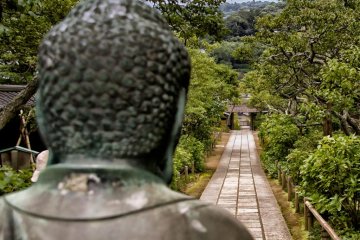
Tōkei-ji, le Temple du Divorce
Brian Wood-KoiwaTōkei-ji, surnommé le "temple du divorce", est un lieu agréable et ombragé à proximité de la station Kita-Kamakura. Appréciez son jardin luxuriant et son ancien cimetière.

Tokeiji, a Rinzai-sect temple of Zen Buddhism, is a branch temple of nearby Engakuji, which is a short 5-minute walk away. This important temple/nunnery was founded in 1285 by the wife of regent Hojo Tokimune as a sanctuary for women who were abused by their husbands. In a time when women could not legally divorce, Tokeiji offered them a three-year training program in return for an official divorce.
The temple’s right to issue divorces was revoked in the early 1870s and its time as a nunnery ended in 1902. Up until 1902, men were strictly forbidden from entering the premises.
Today, all visitors are welcome, and the temple is known for its beautiful flower gardens from summertime hydrangeas to wintertime plum blossoms.
The relatively small complex features multiple structures, including an entrance gate, a bell tower, tea houses, a treasure house, and a main hall. The treasure house holds Buddhist artifacts, as well as lacquer work from past nuns; and the main hall enshrines a seated statue of Shaka Nyorai, the principal image of the temple.
Join the temple for early morning zazen meditation, which is held every Sunday.

Tōkei-ji, surnommé le "temple du divorce", est un lieu agréable et ombragé à proximité de la station Kita-Kamakura. Appréciez son jardin luxuriant et son ancien cimetière.

Au restaurant créatif français 'Nature et Sens', les convives vivent une expérience sensorielle. Les ingrédients de saison et les produits de Kamakura occupent le devant de la scène dans ces plats d'une beauté fantastique. Savourez avec votre repas un verre de vin parmi leur large sélection pour une expérience ultime.

Découvrez le goût dont les habitants de Kamakura sont amoureux. Les génoises moelleuses fourrées à la crème anglaise de New German sont un dessert qui va sans doute vous impressionner. La saveur de crème pâtissière au caramel est particulièrement appréciée par les visiteurs.

Goûtez la célèbre côtelette de porc frite d'Aratama et tombez amoureux de ses saveurs fraîches. Mais le Tonkatsu n'est pas le seul au menu. Ne manquez pas les autres plats d'Aratama comme la mozzarella menchi katsu et la croquette à la crème.

Engakuji is the second most important temple out of Kamakura’s Five Great Zen Temples and was founded by regent Hojo Tokimune in 1282 to commemorate both the Japanese and Mongolian soldiers who lost their lives when Mongolia attempted to invade Japan in 1281 (the Battle of Koan). In 1923, the Great Kanto Earthquake destroyed many, but not all, of the original buildings. Therefore, some of the structures today are relatively modern reconstructions. This principal temple is the head branch school of the Rinzai-sect of Zen Buddhism and some areas of the complex are not open to the public. Even so, the historical structures, ubiquitous nature, and educational atmosphere make for a soul-rejuvenating visit. Engakuji’s bell tower and Shariden Hall are designated as national treasures. For a truly immersive experience, join the temple’s morning zen meditations or enjoy traditional Japanese food and drinks at its tea house, which sells vegetable curry, dumplings, azuki bean sweets, matcha, and amazake (sweet sake).

Fugenzan Meigetsu-in is a Rinzai Zen temple of the Kenchō-ji school in Kita-Kamakura, Kanagawa, Japan. Famous for its hydrangeas, it's also known as The Temple of Hydrangeas. The main object of worship is goddess Shō Kannon. Wikipedia

Kenchoji is Kamakura’s oldest Zen temple and is recognized as the top temple of the city’s Five Great Zen Temples. It was originally founded by regent Hojo Tokiyori in 1253 as a Zen training temple, and its first head priest was a Chinese Zen priest named Rankei Doryu. One of Kenchoji’s defining characteristics is its expansive temple grounds. After the gates and main area, the complex extends deep into the wooded hills. The temple’s main buildings feature traditional Chinese architecture and are arranged in a line, which is characteristic of Chinese Zen Buddhist temples. Kenchoji’s entrance is marked by Somon, a relatively small, yet beautiful, wooden gate that leads to the main gate, Sanmon. This massive wooden structure is meant to relieve you of all your attachments. Just past Sanmon and to the right is the temple’s bell tower, and to the left is a revered juniper tree. This 13-meter-tall tree is estimated to be about 760 years old and allegedly sprouted from seeds brought from China during the temple’s construction. After the gates, the temple buildings stand in a line down the complex. First is Butsuden (Buddha Hall), which enshrines the principal statue of the temple, Jizo Bodhisattva. Directly behind Butsuden is Hatto, the largest wooden temple building in Eastern Japan. When Kenchoji was strictly a training temple, monks would gather in Hatto to listen to priests’ lectures. Inside Hatto is a statue of Senju Kannon and a stunning ceiling painting of a dragon among the clouds. Past Hatto is Hojo; this building was initially the head priest’s residence, but today is popular for its picturesque Zen garden. Sanmon, the bell tower, Butsuden, and Hatto are all designated as National Important Cultural Properties. After the main temple grounds, a path goes further into the forested hillside to Hansobo. This small shrine is dedicated to Hansobo Daigongen, the guardian deity of the temple, and has a small observation deck. A little further past the shrine is a second observation deck where you can observe Mount Fuji on clear days. From this point, there is a one-hour hiking trail that leads to Zuisenji Temple.